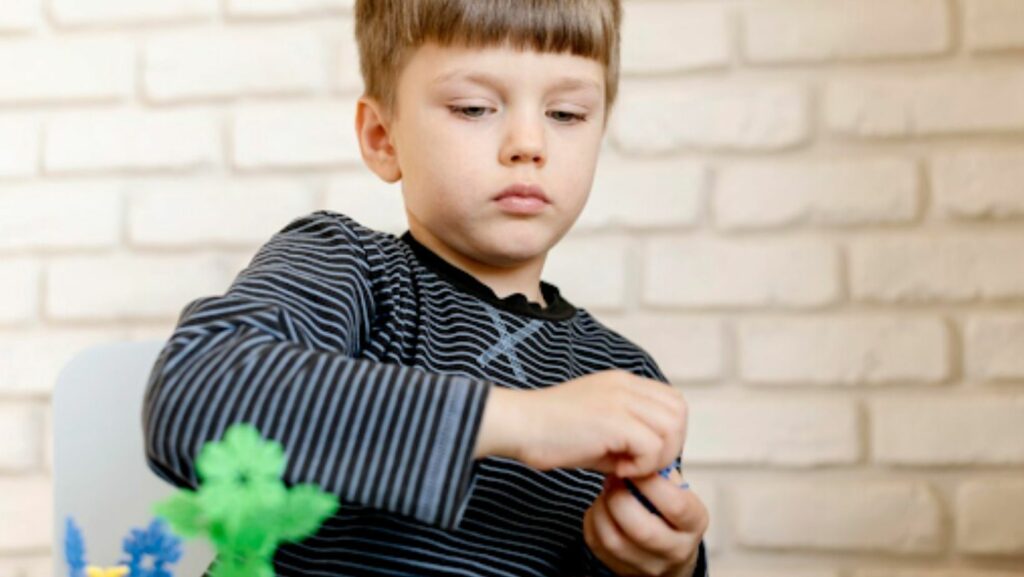The common notion that children with autism lack interest in social interactions is often inaccurate. The truth is that children with ASD lack the necessary tools and skills to convey their thoughts in an effective manner.
This guide addresses various social deficits and strengths children with autism carry and how you can offer support:
Social Deficits in Children with Autism
Children with autism might face the following challenges:
Verbal Communication Challenges
Difficulty in verbal communication is one of the earliest signs of autism in children. Your child might face delayed language development or absence of spoken language. They might not be able to form grammatically correct sentences or use appropriate intonation.
Many autistic children use echolalia, which is the precise repetition of words or phrases spoken by others. It is a way of communication for people when they struggle to form their own spontaneous speech. Autistic children also exhibit unusual speech patterns, such as a monotonous voice.
Non-verbal Communication Challenges
Non-verbal communication is a crucial aspect of social development, but children with ASD often face challenges in this area. It could be as simple as not responding to gestures like waving and pointing.
Many autistic children avoid making eye contact and struggle to interpret facial expressions, such as smiles as signs of happiness and frowns as signs of sadness. They might not pick up on subtle body language cues, such as leaning forward to show interest or crossing arms to indicate discomfort.
Lack of Understanding of Social Cues
Delay or failure to understand social cues is another type of social deficit in autistic children. An autistic child might not recognize sarcasm or excitement in someone’s voice. They might interpret words or phrases literally without considering the social or emotional context.
In addition, people with ASD struggle to grasp unwritten rules of social interactions, such as knowing when to change a topic or taking turns in a conversation.
Repetitive Behaviors
People with ASD might exhibit repetitive behaviors, also known as stimming. Some autistic children like to constantly flap their hands, while others rock back and forth and wiggle their fingers. In many cases, it is your child’s coping mechanism. However, stimming can hinder social interactions and limit their abilities to form connections.
Social Strengths in Autistic Children
You might not hear this often, but your child has incredible social strengths that can shine in the right environment. Here are some examples:
Direct Communication
Autistic children prefer to take part in direct and concise communication.

They can express their opinion without needing to use gestures or maintaining eye contact. Your child’s well-being doesn’t depend on adhering to complex social cues or having “friendly” facial expressions.
Authentic Relationships
Your child might struggle to make friends at the park, but when they do, it will be beyond casual conversation. Autistic children often get close to a few family members, age-fellows, and caregivers at a dedicated autism daycare. They engage in a mutually enjoyable activity. They don’t have to fit the mold of a typical friendship to socialize.
Autistic people thrive in relationships that provide a sense of support and comfort.
Deep Interests
Autistic people bond with peers and even people above their age based on shared interests, be it space or geography. Their profound level of interest and knowledge in a topic sparks conversation and boosts their social confidence. When autistic children interact with people who keenly listen to their interests and reciprocate them, they are likely to get over the fear of social engagement.
Non-judgemental Listening
Autistic people have a literal perception of the word, and that’s completely okay! It allows them to be non-judgemental and paves the way for a deeper understanding of sensitive topics. As a result, your autistic child might show empathy in their own way.
Ways to Improve Social Skills in Autistic Children
Here’s what you can do to improve your child’s social skills:
Role Playing
Role-playing is one of the most effective ways to improve social skills. You can include scenarios like sharing toys, greeting someone at the park, ordering food, or asking for home. Start with basic everyday scenarios and practice them frequently before moving on to the more complex ones.
You can use visual aids, such as charts, pictures, and even written scripts, to help your child understand the social situation and context. Your child can practice in a controlled environment and build an understanding of social cues. As a result, they will be more excited to use their newly acquired skills, making socialization more enjoyable and less intimidating.
Reinforcing Positive Behavior
Every child wants to be appreciated by people they love and care about. Positive reinforcement can take various forms. You can give verbal praise with enthusiasm, like saying “Great job!” when they return your high-five. Or you can give them their favorite snack or toy.
Positive reinforcement will make your child feel confident about their abilities. It can positively improve their attitude towards learning and make it a fun experience.
Activities to Recognize Thoughts and Feelings
As mentioned earlier, children with autism might struggle to recognize facial expressions and body language cues. As a result, they are less able to meet people’s emotional and cognitive needs. One way to reduce this is to do activities where you encourage your child to recognize thoughts and feelings.

Start with showing your child pictures of people exhibiting varying emotions. Start with basic facial expressions, such as happy, sad, or angry, before moving towards more complex ones, such as embarrassed or shy. Ask your child what the person in the picture is feeling.
Once they seem to identify emotions correctly, move towards more advanced instructions and ask them the “why” behind emotions. If the character is participating in social situations, you can easily teach them the meaning and reason behind certain facial expressions.
Social Stories
First developed by Carol Gray in 1991, social stories help autistic children understand and navigate social situations. They are written in a first-person perspective with positive and instructional language to provide complete understanding.
Often known as social scripts, these stories reduce the fear associated with social interactions and build confidence.
Looking Ahead
Social skills are vital to everyday life. For children with ASD, learning social skills is difficult but not impossible. By identifying their strengths and using the right strategies, you can prepare your child to take part in conversations and build meaningful connections.

